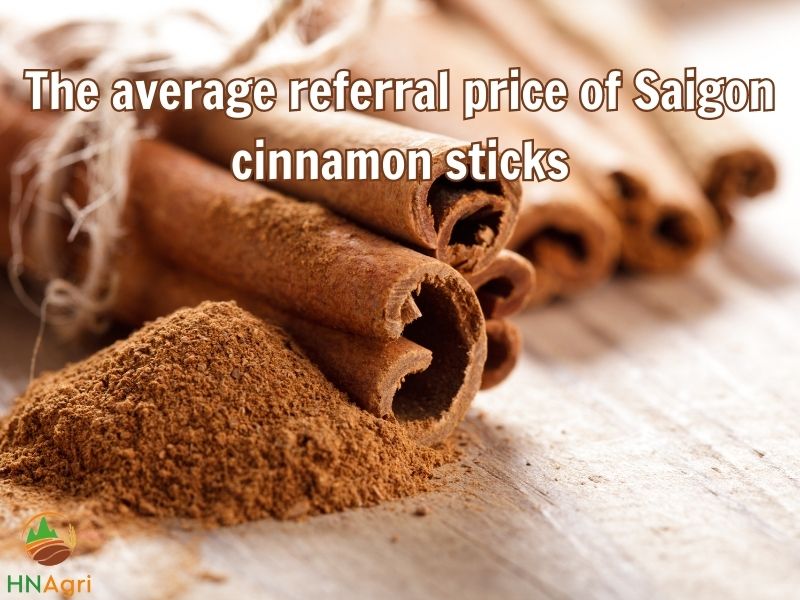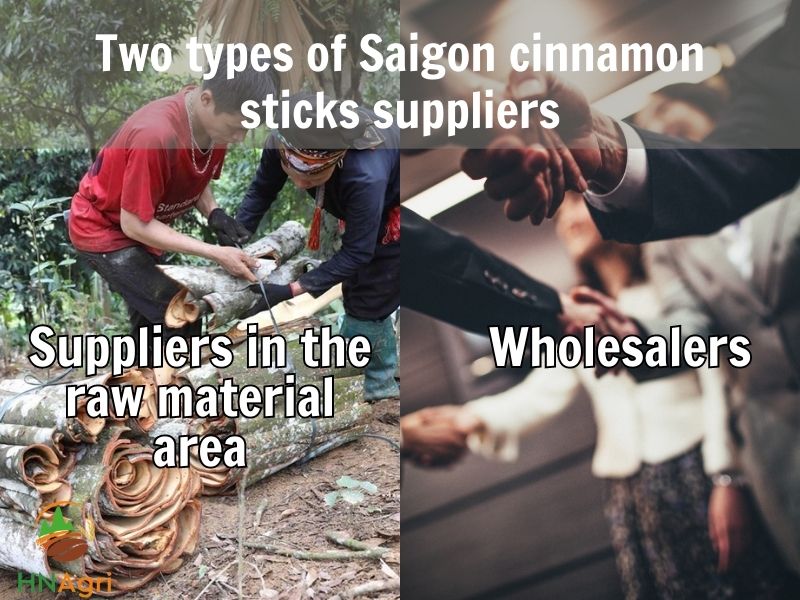Have you ever pondered the remarkable financial gains and income that could be derived from the importation of Saigon cinnamon sticks? This article endeavors to uncover the response by offering invaluable perspectives.
Table of contents
1. Concise overview of Saigon cinnamon sticks
To establish a comprehensive comprehension, this introductory segment will provide an outline and fundamental features of stick Saigon cinnamon, which are crucial to grasp.

1.1. Special features of Saigon cinnamon sticks
Saigon sticks cinnamon have various distinguishing characteristics that set them unique. Below are several distinguishing features:
| Color | Reddish-brown to dark brown color |
| Taste | Strong, pungent, and slightly sweet flavor |
| Aroma | Highly aromatic and spicy scent |
| Oil content | Relatively high |
| Moisture | 14% |
| Coumarin | High level of coumarin |
| Average length | 5 to 10 centimeters |
| Skin thickness | Relatively thick and sturdy |
| Scroll rate | Tight scroll rate, the layers of the bark are tightly wound around each other |
Saigon cinnamon sticks, also referred as Vietnamese cinnamon sticks, stand out with their reddish-brown to dark brown color, strong and pungent flavor, and captivating spiciness. They have a relatively high oil content and a low moisture content, ensuring a longer shelf life. It’s important to note their higher coumarin content compared to other cinnamon varieties. With an average length of 5 to 10 centimeters, these sturdy sticks feature a thick skin and a tight scroll rate. Overall, cassia cinnamon sticks offer a visually appealing, flavorful, and aromatic experience in the world of spices.

1.2. Saigon cinnamon stick production areas and quantity
According to the General Agency for Forestry, Saigon sticks cinnamon have a growing area of roughly 160,000 hectares. Lao Cai, Yen Bai, and Quang Nam provinces have the most extensive cinnamon farming, accounting for over 70% of the nation’s cinnamon stick cultivation area. Cinnamon stick deposits have been projected to be about 500 thousand and one million tons per year. Cinnamon sticks production yields approximately 50 to 60 thousand tons per year on average.
According to recent research, Saigon cinnamon sticks are in great demand, making it a potentially rewarding investment for wholesalers looking to get their hands on the product.

1.3. How to maintain and preserve Saigon cinnamon sticks
To preserve and store stick Saigon cinnamon, follow these guidelines:
- Container: Use an airtight container.
- Location: Store in a cool, dark place.
- Humidity: Keep away from high humidity areas.
- Cleanliness: Handle with clean hands or utensils.
- Freshness: Regularly check for freshness.
By following these storage practices, you can preserve the flavor, aroma, and quality of Saigon cinnamon sticks for an extended period, ensuring they remain delightful for your culinary endeavors.
1.4. Why are Saigon cinnamon sticks becoming increasingly common
Because of its versatility, extended shelf life, and simplicity of processing and handling, Saigon sticks cinnamon are the most frequently produced kind of cinnamon and have the highest quantity:
- Versatile usages: Stick Saigon cinnamon can be used whole in cooking, medicinal, and adornment, and it can also be processed into powder when needed.
- Longer Lifespan: When compared with cinnamon powder, oil, or broken pieces, Saigon cinnamon sticks have an extended lifespan. Their tightly wrapped structure helps to keep the aroma and taste for a longer amount of time.
- Convenience of Preparation and Handling: Cinnamon sticks demand the least amount of processing when compared to other types of cinnamon. The cinnamon bark simply needs to be dried and wrapped into sticks after harvesting, making it a reasonably simple and quick procedure.

2. The developed potential when importing Saigon cinnamon sticks
Importing Saigon sticks cinnamon holds immense potential due to three key factors: Saigon cinnamon’s reputation, government support, and stable pricing.
- Reputation: Cinnamon Saigon has established a strong reputation within the industry. Saigon cinnamon is highly sought after by consumers and businesses alike. Importing Saigon cinnamon sticks can leverage its reputation to capture a significant market share and attract discerning customers.
- Government support: With favorable trade policies, streamlined customs procedures, and incentives for exporters, Vietnamese governments can provide an enabling environment for businesses to engage in the import trade. Such support ensures smoother operations, reduced costs, and increased profitability for importers.
- Stable pricing: Saigon sticks cinnamon possess a consistent and predictable pricing environment that allows importers to plan their procurement, pricing strategies, and profit projections with greater confidence. Stable prices also provide stability in the supply chain, fostering long-term partnerships with suppliers and ensuring a reliable source of high-quality cinnamon sticks.

3. The average referral price of Saigon cinnamon sticks
|
Type |
Price/ton |
| Wholesale price | 10700 USD/ton to 11560 USD/ton |
| Retail price | 12870 USD/ton to 13540 USD/ton |
| Export price | 900 USD/ton to 10500 USD/ton |
According to the wholesale price of cinnamon sticks, wholesale costs for Saigon cinnamon sticks are often lower than retail pricing. Wholesalers purchase huge quantities of the goods and redistribute it to merchants, who subsequently sell it to customers. However, because of additional costs associated with worldwide trade, which include fees, transportation expenses, and customs charges, export prices might vary from both retail and wholesale pricing.
However, the cost of Saigon sticks cinnamon might be influenced by some factors including supply and demand dynamics, harvesting conditions, geographic location, quality and grading, currency exchange rates, trade policies, and market competition.

4. Understanding about Saigon cinnamon sticks suppliers.
It is critical for effective trading to distinguish between trustworthy and untrustworthy sellers of Saigon sticks cinnamon from Vietnam. We provide useful information to assist you in determining how to buy this cinnamon.
4.1. Two types of Saigon cinnamon sticks suppliers
There are two types of suppliers in the Saigon cinnamon sticks market: raw material area suppliers and wholesalers.
- Suppliers in the raw material area have the ability to locate their individual sources of raw material, handle manufacture and export themselves, and so provide a consistent supply.
- Wholesalers buy in bulk and sell to retailers, providing transparency, competitive pricing, and community support.

4.2. Signs of fraudulent Saigon cinnamon sticks suppliers
Identifying signs of fraudulent Saigon cinnamon stick suppliers is crucial to ensure you’re dealing with reputable sources. Here are some signs to watch out for:
- Suspiciously low prices: Be cautious of suppliers with significantly lower prices than the market average.
- Inconsistent quality: Watch out for variations in the quality, appearance, or aroma of the Saigon cinnamon sticks.
- Lack of proper labeling/documentation: Genuine suppliers provide appropriate labeling, packaging, and documentation.
- Limited transparency: Suppliers unwilling to share detailed information about sourcing, production methods, or quality control.
- Unreliable delivery/communication: Continuous shipment delays, poor communication, or unresponsive customer service.
- Absence of certifications: Legitimate suppliers often possess relevant certifications (e.g., organic, fair trade).
- Negative reviews/complaints: Multiple negative reviews or unresolved complaints about the supplier.

4.3. Trustworthy Saigon cinnamon sticks suppliers that you should know
Here are the top five reliable suppliers of Saigon sticks cinnamon with whom you might consider working:
- Hanoi Cinnamon is one of the most well-known leading cinnamon companies. They have established themselves as a prominent participant in the business due to their devotion to excellent goods as well as their early entrance into the cinnamon export market. Because of their competitive pricing tactics, cooperating with Hanoi Cinnamon can result in large profits for distributors.
- Vina Samex: With about a century of industry experience, Vina Samex is an established producer of Saigon cinnamon sticks. They acquire cinnamon from Mekong Delta farmers and achieve high quality standards through stringent quality control techniques. They are given possession of premium-grade cinnamon because of their wide range among producers and traders in Vietnam. Vina Samex is dedicated to fulfilling worldwide standards and thorough quality control.
- Nghi Son Foods Group: Nghi Son Foods Group is a top exporter of Saigon sticks cinnamon, and they are known for their dedication to supplying high-quality products. They have an extensive worldwide network and seasoned personnel who have a plethora of experience serving clients all around the world. Their team includes professionals in the Vietnamese cinnamon market. Nghi Son Foods Group also has a comprehensive quality control system in place to ensure compliance with international standards.
- Agrideco Vietnam Co.Ltd: Agrideco Vietnam lays a major emphasis on sustainability and ethical standards, which they value. They actively work with farmers in the region to grow and consume cinnamon in a way that respects the environment, while also fostering local economic development. Furthermore, Agrideco Vietnam is committed to fair pricing and labor policies, ensuring the safety and respect of all people involved in the manufacture of Saigon sticks cinnamon.
- K-Agriculture: Founded in 1996, K-Agriculture is a well-known firm that specializes in the manufacturing and shipping of Saigon sticks cinnamon to a variety of global locations. They have successfully provided cinnamon to over 80 nations globally in their over twenty years of experience. The company takes satisfaction in its contemporary manufacturing facilities, which are capable of producing several types of cinnamon according to its consumers’ unique needs.






